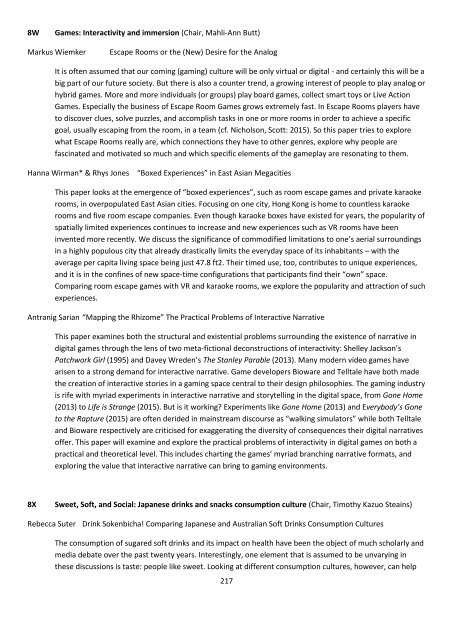Crossroads in Cultural Studies Conference 14-17th December 2016 Program Index
Crossroads-2016-final-draft-program-30-Nov
Crossroads-2016-final-draft-program-30-Nov
You also want an ePaper? Increase the reach of your titles
YUMPU automatically turns print PDFs into web optimized ePapers that Google loves.
8W<br />
Games: Interactivity and immersion (Chair, Mahli-Ann Butt)<br />
Markus Wiemker<br />
Escape Rooms or the (New) Desire for the Analog<br />
It is often assumed that our com<strong>in</strong>g (gam<strong>in</strong>g) culture will be only virtual or digital - and certa<strong>in</strong>ly this will be a<br />
big part of our future society. But there is also a counter trend, a grow<strong>in</strong>g <strong>in</strong>terest of people to play analog or<br />
hybrid games. More and more <strong>in</strong>dividuals (or groups) play board games, collect smart toys or Live Action<br />
Games. Especially the bus<strong>in</strong>ess of Escape Room Games grows extremely fast. In Escape Rooms players have<br />
to discover clues, solve puzzles, and accomplish tasks <strong>in</strong> one or more rooms <strong>in</strong> order to achieve a specific<br />
goal, usually escap<strong>in</strong>g from the room, <strong>in</strong> a team (cf. Nicholson, Scott: 2015). So this paper tries to explore<br />
what Escape Rooms really are, which connections they have to other genres, explore why people are<br />
fasc<strong>in</strong>ated and motivated so much and which specific elements of the gameplay are resonat<strong>in</strong>g to them.<br />
Hanna Wirman* & Rhys Jones<br />
“Boxed Experiences” <strong>in</strong> East Asian Megacities<br />
This paper looks at the emergence of “boxed experiences”, such as room escape games and private karaoke<br />
rooms, <strong>in</strong> overpopulated East Asian cities. Focus<strong>in</strong>g on one city, Hong Kong is home to countless karaoke<br />
rooms and five room escape companies. Even though karaoke boxes have existed for years, the popularity of<br />
spatially limited experiences cont<strong>in</strong>ues to <strong>in</strong>crease and new experiences such as VR rooms have been<br />
<strong>in</strong>vented more recently. We discuss the significance of commodified limitations to one’s aerial surround<strong>in</strong>gs<br />
<strong>in</strong> a highly populous city that already drastically limits the everyday space of its <strong>in</strong>habitants – with the<br />
average per capita liv<strong>in</strong>g space be<strong>in</strong>g just 47.8 ft2. Their timed use, too, contributes to unique experiences,<br />
and it is <strong>in</strong> the conf<strong>in</strong>es of new space-time configurations that participants f<strong>in</strong>d their “own” space.<br />
Compar<strong>in</strong>g room escape games with VR and karaoke rooms, we explore the popularity and attraction of such<br />
experiences.<br />
Antranig Sarian “Mapp<strong>in</strong>g the Rhizome” The Practical Problems of Interactive Narrative<br />
This paper exam<strong>in</strong>es both the structural and existential problems surround<strong>in</strong>g the existence of narrative <strong>in</strong><br />
digital games through the lens of two meta-fictional deconstructions of <strong>in</strong>teractivity: Shelley Jackson’s<br />
Patchwork Girl (1995) and Davey Wreden’s The Stanley Parable (2013). Many modern video games have<br />
arisen to a strong demand for <strong>in</strong>teractive narrative. Game developers Bioware and Telltale have both made<br />
the creation of <strong>in</strong>teractive stories <strong>in</strong> a gam<strong>in</strong>g space central to their design philosophies. The gam<strong>in</strong>g <strong>in</strong>dustry<br />
is rife with myriad experiments <strong>in</strong> <strong>in</strong>teractive narrative and storytell<strong>in</strong>g <strong>in</strong> the digital space, from Gone Home<br />
(2013) to Life is Strange (2015). But is it work<strong>in</strong>g? Experiments like Gone Home (2013) and Everybody’s Gone<br />
to the Rapture (2015) are often derided <strong>in</strong> ma<strong>in</strong>stream discourse as “walk<strong>in</strong>g simulators” while both Telltale<br />
and Bioware respectively are criticised for exaggerat<strong>in</strong>g the diversity of consequences their digital narratives<br />
offer. This paper will exam<strong>in</strong>e and explore the practical problems of <strong>in</strong>teractivity <strong>in</strong> digital games on both a<br />
practical and theoretical level. This <strong>in</strong>cludes chart<strong>in</strong>g the games’ myriad branch<strong>in</strong>g narrative formats, and<br />
explor<strong>in</strong>g the value that <strong>in</strong>teractive narrative can br<strong>in</strong>g to gam<strong>in</strong>g environments.<br />
8X<br />
Sweet, Soft, and Social: Japanese dr<strong>in</strong>ks and snacks consumption culture (Chair, Timothy Kazuo Stea<strong>in</strong>s)<br />
Rebecca Suter Dr<strong>in</strong>k Sokenbicha! Compar<strong>in</strong>g Japanese and Australian Soft Dr<strong>in</strong>ks Consumption Cultures<br />
The consumption of sugared soft dr<strong>in</strong>ks and its impact on health have been the object of much scholarly and<br />
media debate over the past twenty years. Interest<strong>in</strong>gly, one element that is assumed to be unvary<strong>in</strong>g <strong>in</strong><br />
these discussions is taste: people like sweet. Look<strong>in</strong>g at different consumption cultures, however, can help<br />
217


